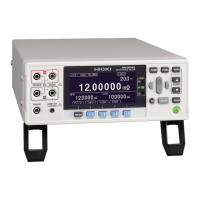Appendix 5 Temperature Conversion (T) Function
A6
Utilizing the temperature-dependent nature of resistance, the temperature conversion func-
tion converts resistance measurements for display as temperatures. This method of tem-
perature conversion is described here.
According to IEC 60034, the resistance law may be applied to determine temperature
increase as follows:
Example
With initial resistance
R
1
of 200 m at initial temperature t
1
of 20°C, and final resistance R
2
of 210 m at current ambient temperature t
a
of 25°C, the temperature increase value is
calculated as follows:
Therefore, the current temperature
t
R
of the resistive body can be calculated as follows:
For a measurement target that is not copper or aluminum with a temperature coefficient of
α
t0
, the constant k can be calculated using the formula shown for the temperature correc-
tion function and the above formula, as follows:
For example, the temperature coefficient of copper at 20°C is 3930 ppm/°C, so the constant
k in this case is as follows, which shows almost the same value as the constant for copper
235 defined by the IEC standard.
Appendix 5 Temperature Conversion (T)
Function
Δt =
R
2
( k + t
1
) − ( k + t
a
)
R
1
Δt Temperature increase [°C]
t
1
Winding temp. [°C, cool state] when measuring initial resistance R
1
t
a
Ambient temp. [°C] at final measurement
R
1
Winding resistance [] at temp. t
1
(cool state)
R
2
Winding resistance [] at final measurement
k Reciprocal [°C] of temp. coefficient of conductor material at 0°C
Δt =
R
2
(k + t
1
) − (k + t
a
)
R
1
=
210 × 10
-3
(235 + 20) − (235 + 25)
200 × 10
-3
= 7.75°C
t
R
= t
a
+ Δt = 25 + 7.75 = 32.75°C
k =
1
3930 × 10
-6
− 20 = 234.5

